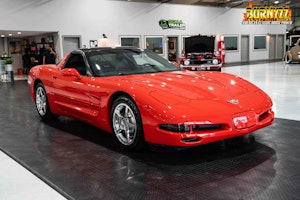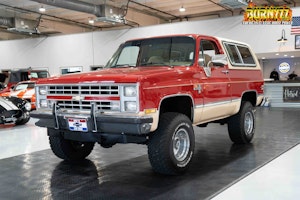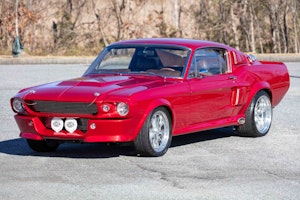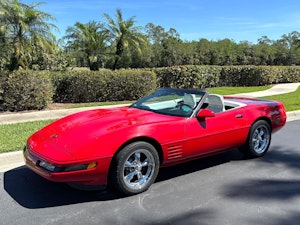Media | Articles
5 Project Cars Reserved for the Brave
Undertaking any project car is not for the faint of heart. Generally speaking, being the sole funding and labor to keeping an aging vehicle in safe operating condition will take everything you are willing to give. However, that doesn’t mean there isn’t a hierarchy of craziness to projects.
Starting an old Ford tractor is one end of the spectrum. Far, far way, on the other end, money disappears quickly, parts often don’t exist, and any task requires a mix of jeweler’s precision and brute force. These are the project cars only undertaken by people who have motivations that might not always make sense to the average person. These are not projects that have high monetary ROI, but in a world where restoring cars is done by people who are not in it for the money anyway, these are the cars that require only the bravest DIYers.
Aston Martin Lagonda

With only 645 built over a span of 14 years, the Lagonda is a rare example of a long-running yet low-production car. The Lagonda is also a notoriously complex machine. All cars are complex at some level, but Aston really outdid itself here. The dashboard on the later production cars switched from LED lighting to cathode ray tubes, which was a sizable step backwards at a time in production when bugs are usually getting worked out of models rather than being added. Complicated beyond words and low volume? DIY only if you dare.
Maserati BiTurbo

Project cars often stem from those looking to take an affordable version of a desirable or interesting car and bring it back to life. Deferred maintenance is very common in this segment. If there was ever a car to highlight what happens when maintenance is ignored, it is the BiTurbo. It was a model made to be the affordable option for the marque and thus many went to buyers unprepared for the complications and needs that come with a twin-turbocharged Italian luxury car. Well maintained, these cars thrived, but those that have reached project-car status likely have issues stemming from the empty maintenance log. Catching up on multiple line items at once adds up quickly any way you total it.
Citroën SM

It takes a car so intriguing as the SM for anyone to tolerate a suspension that required coining new terms just to produce it. The hydropneumatic suspension that makes the ride quality unlike anything else requires “suspension spheres,” which function similar to an accumulator and a spring combined. It’s luxury, it’s French, it’s complicated. It’s a perfect storm, and some people just love to chase tornados. Kudos if you are one of them.
Marketplace
Buy and sell classics with confidence
Audi Allroad

Before the Safari movement, there was the Audi Allroad; an all-wheel-drive wagon with adjustable air suspension to maximize ground clearance, along with a wider track for good measure. It’s not a true off-roader, but it sure was a lot more than anyone needed just for the street. From its 1999 introduction, the Allroad gained a cult following that continues today. The presence of such loyalty stems from an enthusiastic community of people willing to sort out what seems like near-constant issues in even well-maintained examples. All that work done in the confines of an engineer’s dream—and a mechanic’s nightmare.
Fisker Karma

It’s late-model, it’s a complicated hybrid, and the company has gone bankrupt twice in less than two decades. A Karma might just be the most difficult car to work on—that I’m aware of anyhow. One was once donated to a museum and put on display for six months, only for the battery to die, leaving the car stranded exactly where it was, as there was was no way to disengage the electric parking brake. The museum staff consulted the owners manual but all that amounted to was being told “consult a dealer,” which at the time hadn’t been around for years. The last effort was to try to locate and contact a technician who worked at the dealership before it closed. There is hard-to-find information, and then there is becoming a private investigator just to be able to do even the bare minimum of work on your car.
If you notice a theme on these, it’s that the cars themselves aren’t what makes them bad projects, but rather the other factors that are common to the cars we love but are lacking here: support and knowledge, and parts and their availability. That’s why it takes someone ready for a challenge to take these on. Those who are willing just get to experience more and greater lows, but also the accompanying highs. Kudos to them.

















Brave — and very WEALTHY!
Despite it being a coined word, I believe that “hydropnuematic” is miss-spelled. The pneumatic part.
– Your Steadfast Proofreader
I pneu it! Thanks for the correction.
you misspelled miss-spelled.
Funny!
Well done!
Now that’s irony.
This is why I never play grammar police.
Who said I ain’t no good at grammar?
Keeping my 1997 Plymouth Neon on the road is challenge enough, especially with interior parts and weather strips
Lets not forget head gaskets
Watch the Doug DeMuro review of the Karma and you will run. A beautiful Fisker design that will never run.
Let us = Let’s
I’ll learn ya how to write
God bless you.
I never make spelling misteaks.
A little sauce on that steak?
Miss, whatever her name was…
The other part that is a bit off is, technically, the system is an “Oliopneumatic” there was no water involved.
I think it’s oleo (not olio). Maybe there’s a hyphen or a space in there too. So, that would make it either oleo-pneumatic or oleo pneumatic? I’ll leave that question open for the other OCPRD readers (obsessive-compulsive proof reading disorder).
Is anal retentive hyphenated???? Just askin’
https://en.wikipedia.org/wiki/Oleo_strut
Hydro does not refer to water here, but merely a non compressible fluid. Think GM turbo-hydramatic.
Hydramatic ? That automatic was designed to never be dramatic.
Well here we go again. Unscrupulous garages are charging big money for a simple job. Those green spheres are very fundamentally simple. Bot in how the work and replacement which to those in the know is extremely simple economical from a labour perspective. When I lived in Montreal there were and still are several in pendant shops specializing in theses cars and other European makes. My Dentist friend owned an SM. He left on holidays often and I drove and maintained the car.
There are numerous sources for the spheres many reputable most surprisingly inexpensive. Rebuilt units are also on the market. Replacing them is less expensive than shocks on a domestic car. I know I did them and learned how to actually do it myself in a pinch. A little more in depth research could have dispelled this misinformation.
Hear hear Ed! Totally agree. I’m sorting the hydraulics on a Citroën ID19 at the moment, and while it has taken me a bit to get my head around it, the concept and its execution are remarkably simple, just different.
The author didn’t misspell it, you did. Consult your dictionary.
Many years ago I replaced the troublesome an expensive Maserati motor in an SM with a Ford. Much better car, and as reliable as a regular Citroen.
These are models you restore for the love of the model not the investment. Deep Pockets and some creative engineering would be required.
Have a thing for the Lagonda. It’s the car -‘Bond…James Bond’ -would buy/own when he was older. When the repercussions all the ,falls of cliffs, fist fights, gun shot wounds etc had kicked in and taken effect along with arthritis. Hire a sexy as all get out chauffeur, sit in the back and drink shaken not stirreds’ on long rides up the coasts to the casino. Unfortunately I’ll never get there and unfortunately, in another way, I will.
This reminds us that in The Books, Bond *could not afford* a Bentley. He bought a wrecked one, and deliberately cultivated a friendship with a ‘works mechanic’ to get it running. The veddy sexy runabouts in the movies all belonged to the agency, and he had to sign them out.
I remember reading a review of the Loganda back in the day, Car and Driver I think. Apparently the thing went like stink on rails on the autobahn. I remember they mentioned it had touch sensitive buttons (or something similar) on some of the controls, emitting a beep when touched or lightly pushed. Perhaps a first for an automobile?
Last week I couldn’t spell Citroën… HAHAHAHA!
When I was an advisor in the Kingdom, a friend had a Ferrari 400i, a simply brilliant car. One of his business partners had a Lagonda, a fireplace for money even when new. Oh, but dear God did that thing get attention. One could have rolled up to the Riyadh Intercontinental in the Munster’s Koach rolling with Penthouse models and Ted Nugent lighting himself on fire, and everyone would be gathered around the often immobile Lagonda. Lagonda made better cars in the ’20s/’30s imo.
I contest the thought that the Maserati Bi-Turbo thrived if well-maintained. I had a 5-speed convertible for a few years that was a refugee from a friend’s divorce. I loved that dog-leg shifter with 2-5 in the “H”! But no amount of maintenance could keep the fuse block from over-heating and kicking the car into “limp-home” mode. Not to mention that in the summer the radiator could not keep up and you had to run the (very effective) heater to keep the temperature in line. This sucked. It did look cool on the few occasions it worked long enough to drop or pick the kids up from our little parochial school.
It was happily returned to the previous owner once he had recovered some funds. Mice then occupied the cam belts, and they bent all the valves as they died during what became the car’s last attempt at start up.
When it DID work right, it could spin the tires even into 4th gear. But that was rare.
I often thought that it would be a pleasant car with a GM 90-degree V-6 under the hood with an accompanying wiring harness and fuse block. It would not sound as good or be as fast as designed, but it never sounded good or was fast on the back of a tow truck either.
The last of these Bi Turbo’s, mostly with automatics, seemed to get traded in on “Cash for Clunkers” back in the early Obama administration. Sadly, it was true…
Ironically, back in the ’80s, I dreamed of replacing the Buick V6 I had installed in my Triumph TR7 Spider with a Maserati bi-turbo motor. I still own and drive the Spider regularly. The Buick engine is as reliable as a rock. I suspect the Mazza motor would not have been. Some dreams are best ignored.
We must have had a load of horseshoes! I bought a Biturbo as my son’s first car. He drove it year round, here in Canada, and always drove it like he stole it. Never gave any trouble even in the worst weather. The worst was the Alcantara seam splitting in the back seat.
Just “traded” a very low maintenance, dependable accord for a Citroën SM that will be needing more periodic maintenance and care. Maybe crazy, but the car has been well cared for in its life, and I think that with more care it will last to at least 250K miles from the already 154K that it is currently wearing, at which time I’ll be somewhere else enjoying new surroundings. The DS and SM Citroën lines are not to everyone’s taste, but to those of us who have been bitten by the bug, they are beautiful machines, and technically ahead of their time.
Coefficient of drag for the SM was restated as 0.339, compared to the Tesla Roadster at 0.35 / 0.36, and the model S at 0.208. Definitely not a brick going down the road. A true Grand Touring car to enjoy.
I’ve loved the SM since my stepdad’s buddy showed up with one at a cruise in, Indianapolis in the ’80s. And the DS since I saw Duncan McLeod driving one in the Highlander TV series (Adrien Paul). Had I lottery or Leno, my daily good weather car would be a mildly modified SM. Alas, gotta stick with the GTO.
Interestingly, while pointing out Jay Leno’s Citroën SM, you missed the difficulty in restoring, repairing, and maintaining Jay’s Chrysler Turbine Car. Talk about “having to create your own parts…” LOL
I’m still glad that there are people willing to take on projects like these, without regard to cost. Otherwise these bits of history would be lost forever.
I’d love for my 1977 Ford Thunderbird to be insured under Hagerty.
I wouldn’t touch any of them w a barge pole. I can’t tell you; well I could but I won’t, how much I have dumped into projects. A “simple” big block ‘vette that was in good shape to a “well” maintained 911! Mind you my problem is being an engineer I want to make them better! Six figures isn’t as hard as you imagine 😢
Jensen Healeys are no dream either
I put many miles on my Jensen Healey. Replace the points with electronic ignition and they would just keep running. I used mine to commute to work as a truck driver, about 40 miles each way. Yes, I had to sort it first, but once done it took me anyplace I wanted to go, and home again.
The Fisker Karma sounds like a nightmare of future problems.
Yes, but beautiful.
worthy of mention, my first exposure to a Karma was being cut-off by one while I was riding my motorcycle. Lesson learned: Even being in close proximity to one can be hazardous.
so, on the Karma story – am i to understand that the museum couldn’t manage to get the battery replaced?
Best thing to do with a Karma would be a Buick turbo & GM auto tranny driveline swap, a GN in a night-gown if you will. And a GM wiring harness.
More or less make it a reliable kit-car.
Maybe a custom tube frame using only the Fisker bodywork !
There’s a shop in northern IL that could do it, wouldn’t be cheap, but it would be unique.
A lot more fun than a Chevy LS or a Mopar Helephant in anything, which is a lot of what they do.
Swartz Performance in Woodstock/Harvard IL
Gary, are you from n. IL ?
Does the Citroën SM come with Jay Leno?
i hope not!
Restoring a car is tough. Restoring a boat is tough. Restoring a car that is also a boat requires a little insanity. The Amphicar was a limited run car during the 60’s with around only 3500 made. Most sank or rusted beyond repair. The less than one thousand that remain have unique transmissions, require watertight bodywork, and have a limited parts supply. Get past all that and you have one of the most unique rides out there that’s a blast to take on land or sea.
A friend of mine had one. I had to replace the drive axle CV joints after a summer in salt water. The axle was nasty to get at. Driving it down the boat ramp generated delightful expressions on people’s faces. There was only 8″ or so freeboard. The first time I rode in it I thought it was going straight down. Not for rough water.
I think the “SM” in the Citroen stands for sado masochistic. Which is how it treats its mechanics!
Donnie, you made me laugh out loud, Thanks. My dad once had what he called a Merciless Benz.
Hi John, glad I could bring a chuckle to you. Loved your Dad’s Merciless Benz quip.
Speaking of “Mercs”, l bought a lighly-used Mercury Mystique in the late 1990’s and called it the Mercury Mistake. For some reason, it ran rough and none of the local Merc(ury) not Merc(edes) dealers or independent shops could make it run right. It was too bad since that car had really good handling on crooked roads — fun to drive there, but in city traffic it hesitated and hiccuped from a standing start.
You guys rock! In highschool (’70s Indianapolis) my bud had a bench seat column shift ’70 SuperBee, likely the most bizarrely designed car Mopar ever created. After replacing the tired 383 Magnum with a ridiculously built 440 and 727 combo- only the 3800rpm stall converter allowed the thing to idle in gear, and with the apparently bulletproof Mopar 3.23 SureGrip it would destroy tires 2000rpm under the 5700rpm redline- many. Many. Many driveability issues arose. And it was a kid’s daily, so had to run. That car now, 50 years later, is the Stupid Bee. Many good memories there, but many hours of bleeding and frustration as well. Who the @#$& puts a ten inch fang on the front of the hood of a car that needs constant work? Who? I still have scars on my head from that filler panel. IYKYK.
Obviously, you’ve owned a couple !
just about anything can be fixed, restored, modified, all it takes is time and greenbacks.